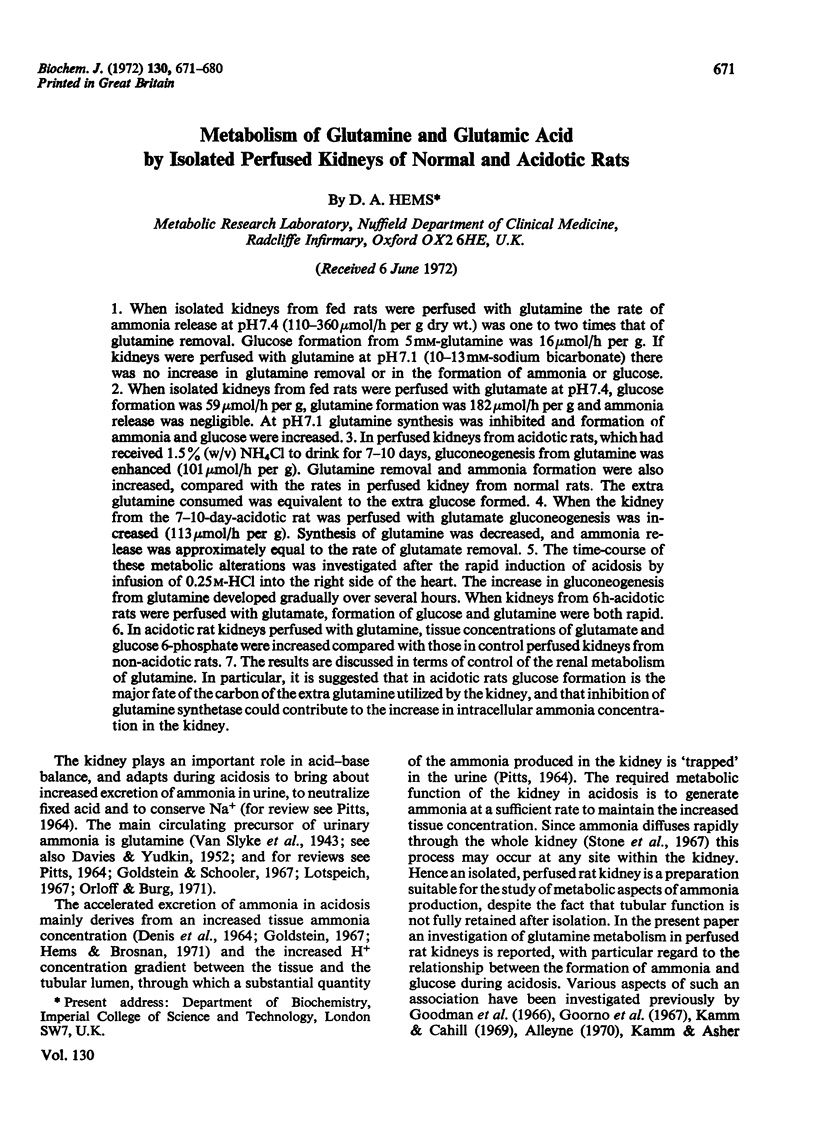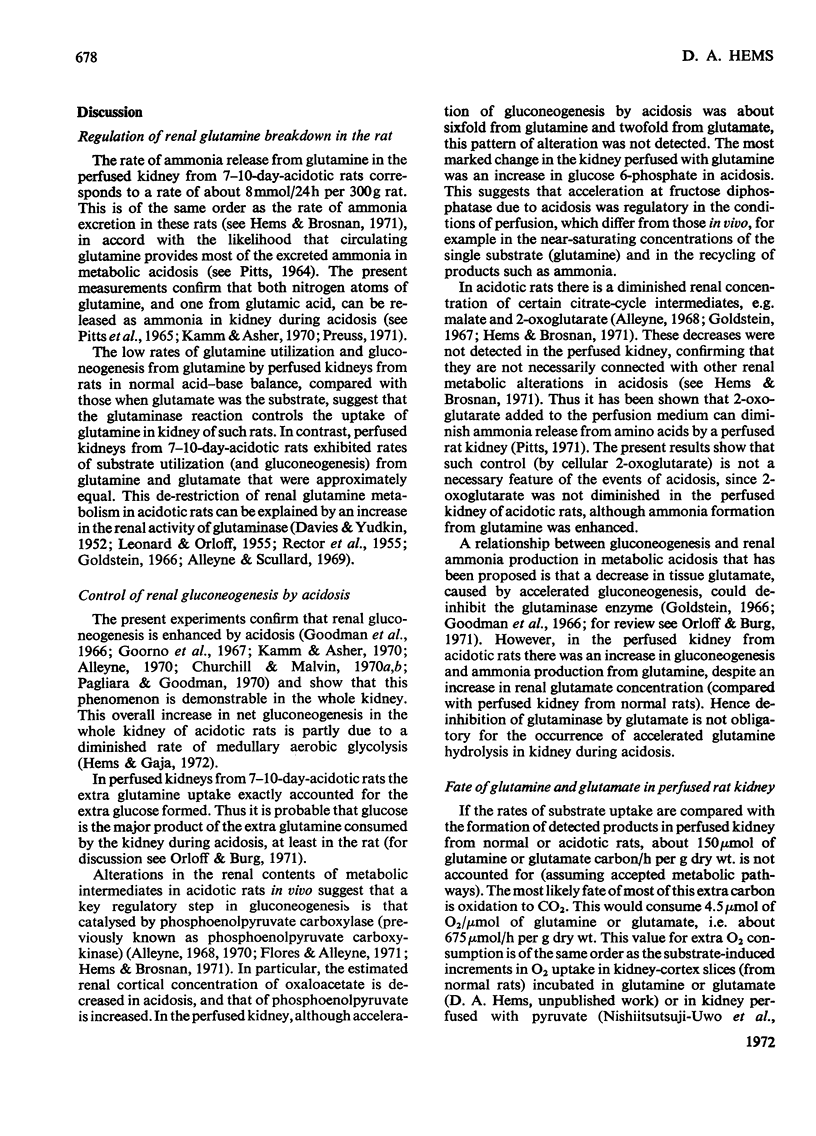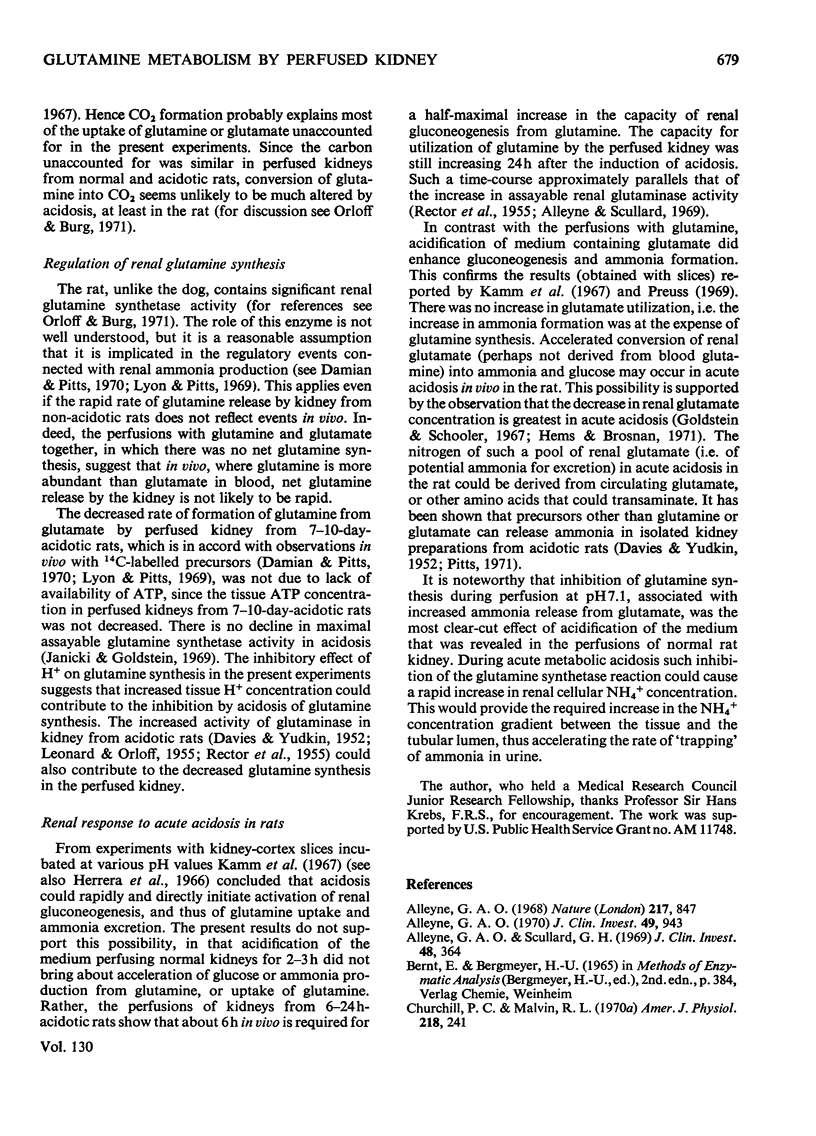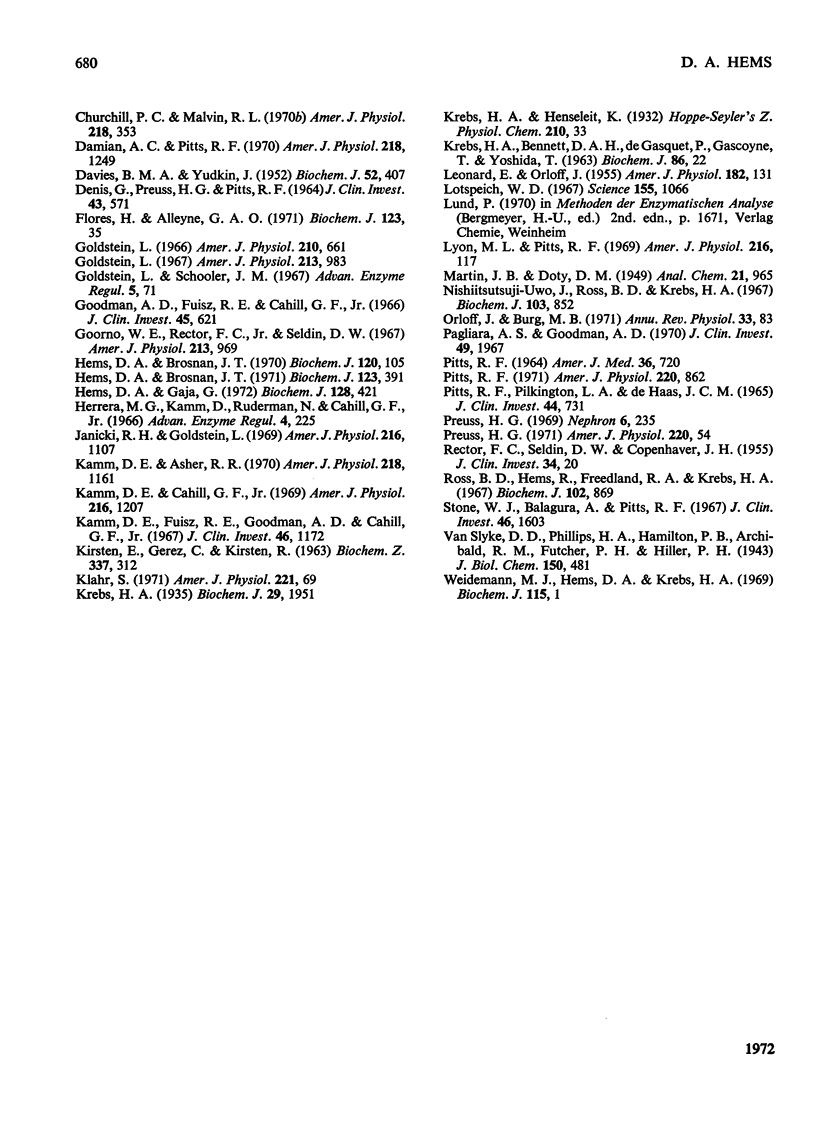Abstract
1. When isolated kidneys from fed rats were perfused with glutamine the rate of ammonia release at pH7.4 (110–360μmol/h per g dry wt.) was one to two times that of glutamine removal. Glucose formation from 5mm-glutamine was 16μmol/h per g. If kidneys were perfused with glutamine at pH7.1 (10–13mm-sodium bicarbonate) there was no increase in glutamine removal or in the formation of ammonia or glucose. 2. When isolated kidneys from fed rats were perfused with glutamate at pH7.4, glucose formation was 59μmol/h per g, glutamine formation was 182μmol/h per g and ammonia release was negligible. At pH7.1 glutamine synthesis was inhibited and formation of ammonia and glucose were increased. 3. In perfused kidneys from acidotic rats, which had received 1.5% (w/v) NH4Cl to drink for 7–10 days, gluconeogenesis from glutamine was enhanced (101μmol/h per g). Glutamine removal and ammonia formation were also increased, compared with the rates in perfused kidney from normal rats. The extra glutamine consumed was equivalent to the extra glucose formed. 4. When the kidney from the 7–10-day-acidotic rat was perfused with glutamate gluconeogenesis was increased (113μmol/h per g). Synthesis of glutamine was decreased, and ammonia release was approximately equal to the rate of glutamate removal. 5. The time-course of these metabolic alterations was investigated after the rapid induction of acidosis by infusion of 0.25m-HCl into the right side of the heart. The increase in gluconeogenesis from glutamine developed gradually over several hours. When kidneys from 6h-acidotic rats were perfused with glutamate, formation of glucose and glutamine were both rapid. 6. In acidotic rat kidneys perfused with glutamine, tissue concentrations of glutamate and glucose 6-phosphate were increased compared with those in control perfused kidneys from non-acidotic rats. 7. The results are discussed in terms of control of the renal metabolism of glutamine. In particular, it is suggested that in acidotic rats glucose formation is the major fate of the carbon of the extra glutamine utilized by the kidney, and that inhibition of glutamine synthetase could contribute to the increase in intracellular ammonia concentration in the kidney.
Full text
PDF









Selected References
These references are in PubMed. This may not be the complete list of references from this article.
- Alleyne G. A. Concentrations of metabolic intermediates in kidneys of rats with metabolic acidosis. Nature. 1968 Mar 2;217(5131):847–848. doi: 10.1038/217847a0. [DOI] [PubMed] [Google Scholar]
- Alleyne G. A. Renal metabolic response to acid-base changes. II. The early effects of metabolic acidosis on renal metabolism in the rat. J Clin Invest. 1970 May;49(5):943–951. doi: 10.1172/JCI106314. [DOI] [PMC free article] [PubMed] [Google Scholar]
- Alleyne G. A., Scullard G. H. Renal metabolic response to acid base changes. I. Enzymatic control of ammoniagenesis in the rat. J Clin Invest. 1969 Feb;48(2):364–370. doi: 10.1172/JCI105993. [DOI] [PMC free article] [PubMed] [Google Scholar]
- Churchill P. C., Malvin R. L. Relation of renal gluconeogenesis to ammonia production in the dog. Am J Physiol. 1970 Jan;218(1):241–245. doi: 10.1152/ajplegacy.1970.218.1.241. [DOI] [PubMed] [Google Scholar]
- Churchill P. C., Malvin R. L. Relation of renal gluconeogenesis to ammonia production in the rat. Am J Physiol. 1970 Feb;218(2):353–357. doi: 10.1152/ajplegacy.1970.218.2.353. [DOI] [PubMed] [Google Scholar]
- DAVIES B. M. A., YUDKIN J. Studies in biochemical adaptation; the origin or urinary ammonia as indicated by the effect of chronic acidosis and alkalosis on some renal enzymes in the rat. Biochem J. 1952 Nov;52(3):407–412. doi: 10.1042/bj0520407. [DOI] [PMC free article] [PubMed] [Google Scholar]
- DENIS G., PREUSS H., PITTS R. THE PNH3 OF RENAL TUBULAR CELLS. J Clin Invest. 1964 Apr;43:571–582. doi: 10.1172/JCI104942. [DOI] [PMC free article] [PubMed] [Google Scholar]
- Damian A. C., Pitts R. F. Rates of glutaminase I and glutamine synthetase reactions in rat kidney in vivo. Am J Physiol. 1970 May;218(5):1249–1255. doi: 10.1152/ajplegacy.1970.218.5.1249. [DOI] [PubMed] [Google Scholar]
- Flores H., Alleyne G. A. Phosphoenolpyruvate carboxykinase of kidney. Subcellular distribution and response to acid-base changes. Biochem J. 1971 Jun;123(1):35–39. doi: 10.1042/bj1230035. [DOI] [PMC free article] [PubMed] [Google Scholar]
- Goldstein L. Pathways of glutamine deamination and their control in the rat kidney. Am J Physiol. 1967 Oct;213(4):983–989. doi: 10.1152/ajplegacy.1967.213.4.983. [DOI] [PubMed] [Google Scholar]
- Goldstein L. Relation of glutamate to ammonia production in the rat kidney. Am J Physiol. 1966 Mar;210(3):661–666. doi: 10.1152/ajplegacy.1966.210.3.661. [DOI] [PubMed] [Google Scholar]
- Goldstein L., Schooler J. M. Regulation of ammonia production in the rat kidney. Adv Enzyme Regul. 1967;5:71–86. doi: 10.1016/0065-2571(67)90009-x. [DOI] [PubMed] [Google Scholar]
- Goorno W. E., Rector F. C., Jr, Seldin D. W. Relation of renal gluconeogenesis to ammonia production in the dog and rat. Am J Physiol. 1967 Oct;213(4):969–974. doi: 10.1152/ajplegacy.1967.213.4.969. [DOI] [PubMed] [Google Scholar]
- Hems D. A., Brosnan J. T. Effects of ischaemia on content of metabolites in rat liver and kidney in vivo. Biochem J. 1970 Nov;120(1):105–111. doi: 10.1042/bj1200105. [DOI] [PMC free article] [PubMed] [Google Scholar]
- Hems D. A., Brosnan J. T. Effects of metabolic acidosis and starvation on the content of intermediary metabolites in rat kidney. Biochem J. 1971 Jul;123(3):391–397. doi: 10.1042/bj1230391. [DOI] [PMC free article] [PubMed] [Google Scholar]
- Hems D. A., Gaja G. Carbohydrate metabolism in the isolated perfused rat kidney. Biochem J. 1972 Jun;128(2):421–426. doi: 10.1042/bj1280421. [DOI] [PMC free article] [PubMed] [Google Scholar]
- Herrera M. G., Kamm D., Ruderman N., Cahill Non-hormonal factors in the control of gluconeogenesis. Adv Enzyme Regul. 1966;4:225–235. doi: 10.1016/0065-2571(66)90017-3. [DOI] [PubMed] [Google Scholar]
- Janicki R. H., Goldstein L. Glutamine synthetase and renal ammonia metabolism. Am J Physiol. 1969 May;216(5):1107–1110. doi: 10.1152/ajplegacy.1969.216.5.1107. [DOI] [PubMed] [Google Scholar]
- KIRSTEN E., GEREZ C., KIRSTEN R. [An enzymatic microdetermination method for ammonia, specifically for extracts of animal tissues and fluids. Determination of NH4 ions in blood]. Biochem Z. 1963;337:312–319. [PubMed] [Google Scholar]
- KREBS H. A., BENNETT D. A., DE GASQUET P., GASQUET P., GASCOYNE T., YOSHIDA T. Renal gluconeogenesis. The effect of diet on the gluconeogenic capacity of rat-kidney-cortex slices. Biochem J. 1963 Jan;86:22–27. doi: 10.1042/bj0860022. [DOI] [PMC free article] [PubMed] [Google Scholar]
- Kamm D. E., Asher R. R. Relation between glucose and ammonia production in renal cortical slices. Am J Physiol. 1970 Apr;218(4):1161–1165. doi: 10.1152/ajplegacy.1970.218.4.1161. [DOI] [PubMed] [Google Scholar]
- Kamm D. E., Cahill G. F., Jr Effect of acid-base status on renal and hepatic gluconeogenesis in diabetes and fasting. Am J Physiol. 1969 May;216(5):1207–1212. doi: 10.1152/ajplegacy.1969.216.5.1207. [DOI] [PubMed] [Google Scholar]
- Kamm D. E., Fuisz R. E., Goodman A. D., Cahill G. F., Jr Acid-base alterations and renal gluconeogenesis: effect of pH, bicarbonate concentration, and PCO2. J Clin Invest. 1967 Jul;46(7):1172–1177. doi: 10.1172/JCI105610. [DOI] [PMC free article] [PubMed] [Google Scholar]
- Klahr S. Relation of renal gluconeogenesis to ammonia production in the rabbit. Am J Physiol. 1971 Jul;221(1):69–74. doi: 10.1152/ajplegacy.1971.221.1.69. [DOI] [PubMed] [Google Scholar]
- Krebs H. A. Metabolism of amino-acids: The synthesis of glutamine from glutamic acid and ammonia, and the enzymic hydrolysis of glutamine in animal tissues. Biochem J. 1935 Aug;29(8):1951–1969. doi: 10.1042/bj0291951. [DOI] [PMC free article] [PubMed] [Google Scholar]
- LEONARD E., ORLOFF J. Regulation of ammonia excretion in the rat. Am J Physiol. 1955 Jul;182(1):131–138. doi: 10.1152/ajplegacy.1955.182.1.131. [DOI] [PubMed] [Google Scholar]
- Lotspeich W. D. Metabolic aspects of acid-base change. Science. 1967 Mar 3;155(3766):1066–1075. doi: 10.1126/science.155.3766.1066. [DOI] [PubMed] [Google Scholar]
- Lyon M. L., Pitts R. F. Species differences in renal glutamine synthesis in vivo. Am J Physiol. 1969 Jan;216(1):117–122. doi: 10.1152/ajplegacy.1969.216.1.117. [DOI] [PubMed] [Google Scholar]
- Nishiitsutsuji-Uwo J. M., Ross B. D., Krebs H. A. Metabolic activities of the isolated perfused rat kidney. Biochem J. 1967 Jun;103(3):852–862. doi: 10.1042/bj1030852. [DOI] [PMC free article] [PubMed] [Google Scholar]
- Orloff J., Burg M. Kidney. Annu Rev Physiol. 1971;33:83–130. doi: 10.1146/annurev.ph.33.030171.000503. [DOI] [PubMed] [Google Scholar]
- PITTS R. F., PILKINGTON L. A., DEHAAS J. C. N15 TRACER STUDIES ON THE ORIGIN OF URINARY AMMONIA IN THE ACIDOTIC DOG, WITH NOTES ON THE ENZYMATIC SYNTHESIS OF LABELED CLUTAMIC ACID AND GLUTAMINES. J Clin Invest. 1965 May;44:731–745. doi: 10.1172/JCI105186. [DOI] [PMC free article] [PubMed] [Google Scholar]
- PITTS R. F. RENAL PRODUCTION AND EXCRETION OF AMMONIA. Am J Med. 1964 May;36:720–742. doi: 10.1016/0002-9343(64)90182-2. [DOI] [PubMed] [Google Scholar]
- Pagliara A. S., Goodman A. D. Relation of renal cortical gluconeogenesis, glutamate content, and production of ammonia. J Clin Invest. 1970 Nov;49(11):1967–1974. doi: 10.1172/JCI106416. [DOI] [PMC free article] [PubMed] [Google Scholar]
- Pitts R. F. Metabolism of amino acids by the perfused rat kidney. Am J Physiol. 1971 Apr;220(4):862–867. doi: 10.1152/ajplegacy.1971.220.4.862. [DOI] [PubMed] [Google Scholar]
- Preuss H. G. Ammonia production from glutamine and glutamate in isolated dog renal tubules. Am J Physiol. 1971 Jan;220(1):54–58. doi: 10.1152/ajplegacy.1971.220.1.54. [DOI] [PubMed] [Google Scholar]
- Preuss H. G. Renal glutamate metabolism in acute metabolic acidosis. Nephron. 1969;6(3):235–246. doi: 10.1159/000179731. [DOI] [PubMed] [Google Scholar]
- RECTOR F. C., Jr, SELDIN D. W., COPENHAVER J. H. The mechanism of ammonia excretion during ammonium chloride acidosis. J Clin Invest. 1955 Jan;34(1):20–26. doi: 10.1172/JCI103058. [DOI] [PMC free article] [PubMed] [Google Scholar]
- Ross B. D., Hems R., Freedland R. A., Krebs H. A. Carbohydrate metabolism of the perfused rat liver. Biochem J. 1967 Nov;105(2):869–875. doi: 10.1042/bj1050869. [DOI] [PMC free article] [PubMed] [Google Scholar]
- Stone W. J., Balagura S., Pitts R. F. Diffusion equilibrium for ammonia in the kidney of the acidotic dog. J Clin Invest. 1967 Oct;46(10):1603–1608. doi: 10.1172/JCI105652. [DOI] [PMC free article] [PubMed] [Google Scholar]
- Weidemann M. J., Hems D. A., Krebs H. A. Effects of added nucleotides on renal carbohydrate metabolism. Biochem J. 1969 Oct;115(1):1–10. doi: 10.1042/bj1150001. [DOI] [PMC free article] [PubMed] [Google Scholar]


